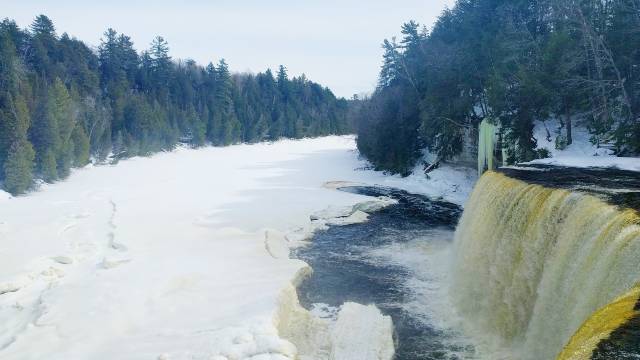By Carol Stiffler
At long last, here’s some wintery weather. Enough inches of snow cover some areas that sledding is possible, and snow plows have emerged from hibernation.
It’s a welcome relief.
“Last fall and early this winter it was really warm and we were not getting snow anywhere in the U.P.,” said Evan Kutta, meteorologist with the National Weather Service in Marquette. “For the most part it was a lot more rain and warmer than normal. Most of that can be attributed to the El Nino.”
El Niño, which means “Little Boy” in Spanish, is a phenomenon that the National Oceanic and Atmospheric Administration (NOAA) summarizes as a “naturally occurring climate pattern associated with warming of the ocean surface temperatures in the central and eastern tropical Pacific Ocean, which can significantly influence weather patterns, ocean conditions, and marine fisheries worldwide.” It typically results in warmer, drier weather.
On the other hand, La Niña, or “Little Girl” in Spanish, brings wetter, colder weather.
We’re almost always in one or the other, Kutta said, with about one in seven years being neutral.
This winter’s El Niño dashed local hopes for a white Christmas, forced the cancellation of the Tahquamenon Country Sled Dog Race, and caused visitors to cancel reservations and rentals.
It’s been an economic trouble for any U.P. industry that relies on visitors at all.
“Nobody is coming up,” Rob Stein, owner of Pine Stump Junction said last week. “Everybody that booked cabins has canceled. There’s no snow.”
Stein hoped guests would reframe the opportunity as a rare chance to visit the area for winter Yooperlight hunting or trail walking. But they didn’t come. He said the warm, dry start to winter has been worse than the early pandemic shutdown in March 2020.
“Boy, the U.P. really needs to use this as a learning experience to be ahead of the curve in case it happens again,” Stein said. “How do you draw that new crowd in? You might not need snow.”
Stein said he’s always working on plans to draw people to the area. Most recently, he developed a nearby three-quarter-mile snowshoe trail, clearing it, leveling the path, and putting up signs. Before the snow hit, he let people walk on the new trail.
Andrew Rasch, Newberry Tourism director, said the best we can do at this time is wait and see.
“We knew it was going to be a rough winter,” he said. “Our strategy is to continue to market the area in general, the area and what we have. We dialed back on ads for snowmobiling, since that’s not a thing right now.”
Rasch advises staying focused. “It will get better. It’s just a matter of facing a challenging season,” he said. “Make sure everything is clean and ready to go for when business starts to kick in.”
There’s at least one silver lining to having a warm, dry start to winter: the deer can still find food on the forest floor.
“It’s not high-quality food, but there’s lots on the ground to eat,” said Kristie Sitar, wildlife biologist with the Michigan Department of Natural Resources. “And it uses less of their fat reserves.”
Harsh winters are the greatest threat to deer survival, Sitar said. The U.P.’s long winters force deer to burn through their fat reserves while waiting for the spring thaw.
“It would be a bigger benefit if this happened on the other end of winter, and spring came early, but we’re still happy to take it while it lasts,” Sitar said. “It gives all of them a little bonus.”
The deer also migrate incrementally when winters start slowly, she said, spending more time in middle areas instead in the heavily browsed deer yards where they’ll spend most of their winter. Deer in northwest Luce County might eventually migrate to the middle of Mackinac County, but when weather is noncommittal like it has been, they pause their migration or even head back north.
“It’s a benefit in that they’re not all the way down in the deer yard,” Sitar said. “Those deer yards have been browsed out for 80 plus years. They’re in the middle areas where they can still find food.”
A warmer, drier winter will likely lead to a dry spring with greater risk of wildfire. Meteorologist Kutta said the NOAA Climate Prediction Center is calling for higher-than-normal temperatures and lower-than-normal precipitation on average through April. Lake levels will reduce due to evaporation while lakes aren’t covered in ice.
But that doesn’t necessarily mean we’re headed into a drought, Kutta said.
“The Climate Prediction Center doesn’t have us in drier or wetter than normal this summer,” he said. “They’re favoring near-normal summer weather. It could just be a dry winter, and a normal summer.”












